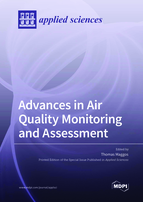Advances in Air Quality Monitoring and Assessment
A special issue of Applied Sciences (ISSN 2076-3417). This special issue belongs to the section "Environmental Sciences".
Deadline for manuscript submissions: closed (28 February 2021) | Viewed by 34714
Special Issue Editor
Interests: air quality; analytical chemistry; atmospheric chemistry; source apportionment, particulate matter; climate change; catalysis
Special Issues, Collections and Topics in MDPI journals
Special Issue Information
Dear Colleagues,
Air quality monitoring is a long-term assessment of pollutant levels that helps to assess the extent of pollution and provide information on air quality trends. Furthermore, an air quality monitoring system (AQMS) supports research by providing the information necessary for scientists to perform long-term studies of the exposure of population to various atmospheric substances and in general to estimate the health effects of air pollution. In addition, an advanced AQMS could make available useful information to policymakers and planners in order to make informed decisions on managing and improving air quality by better understanding the sources of air pollution.
The purpose of this Special Issue is to provide an overview of recent advances in environmental monitoring and assessment that includes the design, development, and application of advanced monitoring systems. These systems should be based on cutting-edge scientific knowledge and not replicate well-known monitoring techniques. Potential topics of the journal include, but are not limited to, technical developments of AQM systems (including advanced sensor technologies), methodological approaches to assess the impact of air pollution in human health, and long-term personal and population exposure assessment studies. Scientific papers dealing with monitoring and health data fusion techniques and evaluation of air quality models using data from advanced AQMS are also encouraged.
Dr. Thomas Maggos
Guest Editor
Manuscript Submission Information
Manuscripts should be submitted online at www.mdpi.com by registering and logging in to this website. Once you are registered, click here to go to the submission form. Manuscripts can be submitted until the deadline. All submissions that pass pre-check are peer-reviewed. Accepted papers will be published continuously in the journal (as soon as accepted) and will be listed together on the special issue website. Research articles, review articles as well as short communications are invited. For planned papers, a title and short abstract (about 100 words) can be sent to the Editorial Office for announcement on this website.
Submitted manuscripts should not have been published previously, nor be under consideration for publication elsewhere (except conference proceedings papers). All manuscripts are thoroughly refereed through a single-blind peer-review process. A guide for authors and other relevant information for submission of manuscripts is available on the Instructions for Authors page. Applied Sciences is an international peer-reviewed open access semimonthly journal published by MDPI.
Please visit the Instructions for Authors page before submitting a manuscript. The Article Processing Charge (APC) for publication in this open access journal is 2400 CHF (Swiss Francs). Submitted papers should be well formatted and use good English. Authors may use MDPI's English editing service prior to publication or during author revisions.
Keywords
- Design of air quality monitoring systems
- Development of AQ monitoring techniques
- Exposure assessment methodologies
- Health impact assessment
- Advanced air quality models based on long-term AQ monitoring
- Data fusion techniques
- Sensors applications for AQ assessment
- Indoor and ambient AQ






